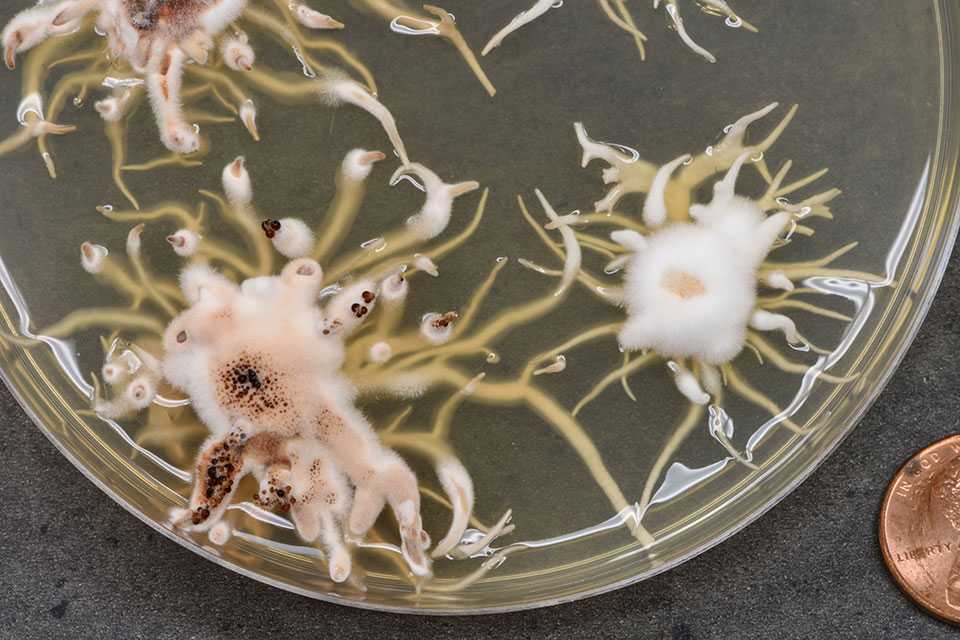Testing for Vegetable Pathogens: Why, What, How, When?

Using microbiological media, plant pathogens such as Armillaria can be recovered and identified.
Photo by Steven T. Koike, Trical Diagnostics
The COVID-19 virus has assaulted communities with unprecedented challenges. Health, social, and economic consequences from this novel virus are new experiences for our world.
However, one aspect of this pandemic is not new to us; COVID-19 reminds us of what we already knew — pathogen testing is essential. Information regarding COVID-19 testing, therefore, serves as a reference point for testing dynamics for plant disease diagnosis in agriculture.
Disease Confirmation and Testing
People realize that testing is absolutely essential for confirming COVID-19. If no test is administered, then there is no possible confirmation that COVID-19 infection took place. Symptoms may be present or absent, mild or severe, but if there is no test, there remains only speculation.
In general, confirmation of a plant pathogen, likewise, is dependent on testing. Like COVID-19, the pathogens that affect plants are not visible with the unaided eye. Microscopic fungi, bacteria, and nematodes, and sub-microscopic viruses can only be detected with appropriate tests. Based on experience, veteran field personnel may have an idea about the possible presence of a pathogen; however, diagnosing the disease without including a test remains, to some degree, a guess in most situations.
Pathogen Diversity
What do we test for in agriculture? Plant disease diagnosis is complicated due to the range of pathogens that cause similar symptoms. A series of fungi, bacteria, or viruses can cause similar symptoms. Therefore, the agricultural diagnostician must sort through the symptoms and arrive at a short list of probable causal agents. Multiple tests are run so that nothing is missed.
Plant pathogens also occur as different strains and variants. The bacterial spot disease of pepper and tomato, for example, is caused by the Xanthomonas bacterium, which is quite diverse and consists of four species. Some of these Xanthomonas isolates infect pepper only, some infect only tomato, while others infect both crops.
Differentiating between the species requires testing. Fusarium yellows of celery is caused by the soilborne pathogen Fusarium oxysporum. In recent years, the new aggressive race 4 of this celery pathogen has caused severe disease. Celery growers cannot know for sure if they have the race 4 problem without a molecular test that is used on symptomatic tissue.

Small pieces of diseased tissue are removed and placed in agar media to allow plant pathogens to be detected.
Photo by Steven T. Koike, Trical Diagnostics
How to Test
Testing for plant pathogens has a lot in common with testing for COVID-19. But first, we must ask the following questions:
(1) Which type of test? Culturing for pathogens is achieved by placing pieces of tissue onto agar-based media. Also, like the medical world, plant pathologists use molecular and serological tools to search for DNA/RNA and protein antibodies, respectively.
(2) How to collect samples? A plant sample that is not collected properly can result in a false diagnosis. A mistake occurs when the proper part of the plant is not submitted. For example, a diseased plant may show symptoms of a foliar disease; field personnel may clip off the shoots and submit them for testing. However, in some situations, a root pathogen may be preventing water and nutrients from reaching the plant’s canopy, resulting in the foliar symptoms. Failure to submit the entire plant would result in a misdiagnosis.
(3) When to test? The onset of symptoms is the time for submitting samples. One can delay and wait too long, however. Plants that are in the late stages of disease development will decline from the pathogen as well as from secondary decay organisms. Testing advanced, decayed samples will result in the recovery of these secondary agents.
Moving Forward with Testing
In this COVID-19 era, testing methods and implementation will move forward. Improved methods will be developed. Testing capacity will increase. Researchers will teach us the optimum ways to deploy the tests, how to collect the best samples, and when to collect them. Agricultural diagnosticians will hopefully also advance the science and practice of plant pathogen testing and diagnosis and embrace new technologies as they develop.










